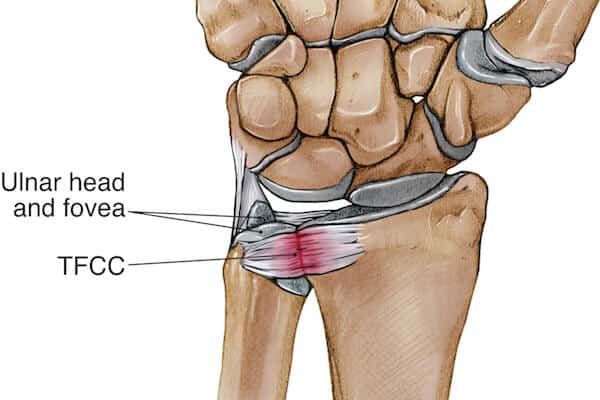TFCC is a medical term which means triangular fibrocartilage complex that is a combination of ligaments and cartilage structure located in the wrist which holds together the arm bones (the radius and the ulna). It serves as a cushion between the ulna bone and the wrist bones (carpals). The structure also has a stabilising function and is responsible for the smooth movement of the wrist joint and stable rotation of the forearm. A tear of the TFCC can cause swollen wrist, wrist pain, loss of grip strength or a combination of these.
TFCC Tear
What is TFCC?

Causes Of TFCC Tear
Typical causes for the triangular fibrocartilage complex to tear are:
- Falls with an extended arm causing the wrist to bend backward.
- Other complex hand/wrist fractures that lead to wrist pain or swollen wrist.
- Excessive arm rotation which causes a loss of grip strength.
- Degenerative disorders due to aging (for people over 50)
- Ulnar Impaction Syndrome (a genetically longer ulna bone which can put extra strain on the cartilage)
Usually, TFCC tears are common for active athletes in sports where additional strain is placed on the hands and wrists, such as racket sports or gymnastics.
Types Of TFCC Tear
There are two types of TFCC tears: traumatic and degenerative (chronic). The first type occurs as a result of injuries while the second develops over time with the natural wearing out of the cartilage with age or as a side effect of inflammatory diseases such as rheumatoid arthritis or gout.
Who Is Likely To Tear Their TFCC?
A TCFF tear can affect anyone. TFCC tear happens most often in those who fall on an outstretched hand. Athletes are usually at risk, particularly those who use a racquet, club or bat and those who put excessive stress on the wrist such as gymnasts. Degenerative tears typically occur in people over the age of 50 years. Every patient is treated with individualised options that are developed to ensure optimal outcomes.
Symptoms Of TFCC Tear
- Swollen Wrist
- Wrist Pain
- Tenderness On The Back Side Of The Wrist
- Inability To Bend The Wrist Up And Down Or Sideways Due To Pain
- Clicking Sound When Moving The Wrist Leading To Wrist Pain
- Loss Of Grip Strength
When presented with these symptoms, a doctor will first perform a manual test putting stress on the cartilage structure to reproduce them. Additionally, an X-ray and an MRI can be used to diagnose a TFCC with greater accuracy, MRI examination is the most accurate method to diagnose the injury.
Conservative Treatment Of TFCC Tear
Less severe cases of TFCC tears can be treated with:
- Cast (for about four weeks)
- Splint (allowing for some movement)
- Anti-inflammatory medication (e.g. ibuprofen – consult your GP before taking medication)
- Corticosteroid injection (e.g. cortisone)
- Electrotherapy (e.g. ultrasound)
Surgery
More severe TFCC tears or degenerative ones which will not heal with conservative treatment can be surgically corrected.
In this case, usually an arthroscopy keyhole incision is made allowing to:
- Clear The Damaged Piece Of Cartilage Off.
- Use Of Sutures To Repair The Damage.
- Cutting Or Shaving Away Of The Ulnar Bone When Too Long To Reduce The Stress It Puts On The TFCC.
How Long Till I Get Better
The time to recovery depends on the specific case, but when a surgical intervention is involved, it can go up to several weeks and can require several weeks in a cast and rehabilitative procedures to regain the full function of the wrist.

New Client Offer - 10% OFF
Are you in pain? Not sure if we can help you?
Book your initial appointment and receive 10% off any service!